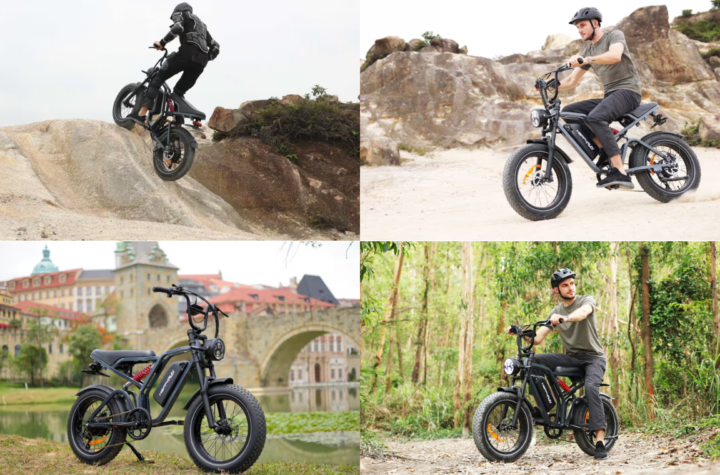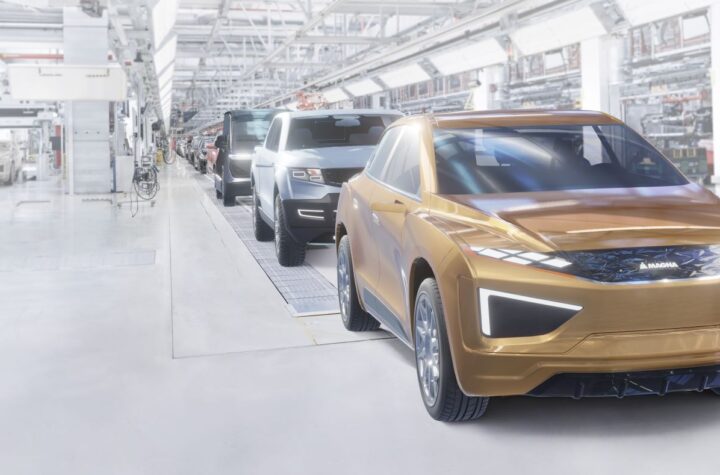




The styling of the production Ridgeline (top) doesn’t stray too far from the concept that graced the stage at the Detroit Auto Show in 2004. The interior is both rugged and user friendly. The tailgat opens like a 1970’s station wagon, either down like a tailgate or out like a door. Patented diamond vortex shapes on the top of the mirror, a technology learned from Formula One racing, cut wind noise 


The unique “trunk” in the bed is sealed from the elements when shut and can hold a 72-qt. cooler or three sets of golf clubs. Ridgeline’s independent rear suspension allows for the plastic box to nestle down between the frame rails. The unit, shipped in pieces, is assembled at the plant and installed in one piece. 


The unibody is built up off of a very sturdy stamped-steel frame. The one-piece side panel required extensive modifications to the press transfer line. An independent rear suspension gives Ridgeline a car-like ride.
The launch of the Ridgeline, Honda’s first pickup truck, could just be one of the most important launches of the decade. There are some that are still having a hard time grasping the concept of a Honda pickup — people like the young salesman at the Honda dealer where we take our Civic for its regular scheduled maintenance. A few Ridgelines had just arrived at the dealership and he looked perplexed.
“I don’t know who’s going to buy those things,” he said.
Hopefully, for Honda’s sake, he’ll soon find out.
Honda is not really new to trucks, if you consider the Element, Pilot (and Acura MDX), CR-V and Odyssey trucks. With sales of those vehicles growing, it was felt that the only way for Honda to grow would be in the pickup truck segment – but what kind of pickup truck, and who would be the customer?
In typical Honda fashion, they asked everybody, conducting 12 focus groups covering the entire country, paying special attention to the areas where the “truck people” live.
“We tried to talk to everybody,” Gary Flint, Large Project Leader, “compact truck owners, full-size truck owners, and we even talked to the heavy-duty guys, the F-350 guys, we didn’t leave anybody out. We surveyed over 40,000 people.”
Honda took note of the shortcomings of the vehicles on the market. The lack of maneuverability and poor ride and handling came up often. Flint had no qualms about building a vehicle that could deliver on those points.
“Additionally,” Flint says, “we heard very strongly, “if I’m going to buy a truck, it’s going to need to do what a truck can do. That’s why I’m purchasing it.”
Development of the vehicle focused on that attribute. Ridgeline needed to be a real half- ton pickup. It needs to be able to tow and it needs a real tailgate — one that can be flipped down and used like a real tailgate.
“That’s why we spent a lot of time on the tailgate,” says Flint who refers to it as ‘an engineering marvel,’ “The tailgate is so strong, I can back two trucks up to each other and I can park another Ridgeway on top of them.”
The tailgate does more than support a lot of weight. The dual hinges allow it to drop down, like a truck, or open to the side like a door, for easy access to the bed.
There is a method behind the design of the five-foot bed. Honda wanted to keep the vehicle compact so it would fit in a standard garage.
“But one of the key pieces of equipment we wanted to transport,” Flint says, “was a large four-wheel ATV,” (Honda, of course). It will fit in the back with the tailgate down.
Ridgeline’s bed is made of a structural SMC composite, a vinylesther/polyesther blend with 40 percent fiberglass reinforcement and has a 1,100-pound cargo capacity.
Unlike composite beds in competitive pickups, the bed in Ridgeline is reinforced with three high-strength steel crossmembers.
“Even if I blatantly overload it and break it,” Flint says, “I can still carry a load. If you do that in the Tacoma it loses any ability to haul a load.”
Though Ridgeline’s integrated body-on-frame construction is similar to Pilot and MDX, Flint says that Ridgeline is not just a bigger Pilot. Ridgeline’s body panels are 93 percent exclusive, sharing just a few minor structural stampings with Pilot. Ridgeline is manufactured at Honda’s Alliston, Ontario, Canada plant on the same line with the Acura MDX and Pilot, though primary production of Pilot was shifted to Lincoln, Ala., where the Odyssey minivan is built, to make room for Ridgeline.
Honda is scheduled to build 50,000 units in the first 12 months. The plant will build 280 Ridgelines a day in two shifts. The trucks are built in lots of 60, one batch, one color and different trim levels within that lot. Full production started Jan. 2 and Flint says that Honda planned to have 4,000 units on the ground, or four per dealer, by March 1, which was the sale date. Flint says they’re starting off slow though they’re ready if demand is greater than the output.
“We know where the limiting volume suppliers are,” Flint says, “and we’ve already expanded the tooling in those areas. So we’re ready to act to the demand if we need to.”
Ridgeline is the biggest vehicle that Honda has ever built. It’s 400mm longer than a Pilot and 100mm longer than the Odyssey. “When you see this on the line, this is the biggest Honda we’ve ever done and we end up hitched between vehicles very tightly,” Flint says, “we’ve really pushed the envelope from a manufacturing standpoint. Though Honda won’t release specific numbers, Flint says that billions of dollars were invested in making changes to the Alliston plant to accommodate Ridgeline. The biggest issue was the one-piece side panel outer. Flint says the die for the piece actually hangs off the stamping press. The stamping area not only saw major modifications, but overhead conveyors and transfers had to be modified to handle the large panels, which are hung vertically on their way to the body shop.
One of the tricks Honda used to make such a larger panel was to modify the front hinge pillar design. The hinge pillar reinforcement and the front half of the hinge pillar, normally formed with the side panel outer, are formed with the reinforcement, “which gave us another inch on the vehicle,” Flint says. Though some digital work was done to see if the larger panel would work, a prototype die was built and run through the system to see where potential problems might exist.
“CG is a wonderful thing,” Flint says, “but there are plants that we have that are old enough that we don’t have digital models of them.” The rear panel on the cab posed the biggest problem for the body shop because it was something that Honda had never done before. “Now I’m welding something into the middle of the car,” Flint says, “which was a huge challenge.”
Honda invested several million dollars in creating a large fixture that swings the panel down from the top, locates the piece and welds it into the vehicle. Another challenge was creating a strong D-pillar to support the tailgate.
“Ideally we would have liked to make that one piece,” says Flint, ‘but it was too high, it wouldn’t have fit through the plant, we would have had to tear the building up.” The solution was to break it up into two pieces, with half of the vertical pillar on the side panel comp welded to a huge ring on the floor comp. Two rough prototypes were built to test vehicle dynamics and validate all of the modeling and development work “to make sure we were going down the right path,” Flint says. “The first one we did actually had a [Ford] SportTrac bed in it,” Flint says.
The second iteration used an MDX cabin with exclusive side panels. That prototype used a production bed. Two complete production-like tools were built to check the construction of the bed. The bed is supplied by Meridian of Huntington, Ind., and shipped in as multiple pieces including the floor comp, the trunk lid, two side panels and head board and tailgate. The pieces are assembled in the plant and installed as a unit, which again, required major modifications to the assembly line. All of the changes in the paint shop were robotic. New robots were added to the paint line and several sealer robots were added to do some extra sealing steps added for Ridgeline.
“We’re spraying PVC on the side sill, which we hadn’t done at this plant,” says Flint. “With robots costing $750,000 each,” Flint says, “it adds up fast. Plus I have to shut the line down during changeover, so I have to engineer when I can install the robot on the line.”
Some modifications were made to the door installation process because Ridgeline uses much heavier full-frame doors as opposed to the sash doors on the MDX and Pilot. Ridgeline shares its MacPherson-strut front suspension geometry with Pilot, though the scrub rating has been changed to accommodate the larger tires. The suspension components themselves were redesigned to increase the strength and durability. The suspension is mounted to a higher-grade steel front sub frame for added strength.
The rear multi-link suspension is completely new and features high-strength steel 3.5 ft. trailing arms and exclusive lower A-arm, and is mounted to a rubber isolated high-strength steel sub-frame. The all-wheel-drive system is a carry-over from MDX and Pilot though the rear differential has been modified, included the rerouting of the plumbing and hardware so the vehicle would be able to forge water. The rest of the changes are all software related. It wouldn’t be wrong to say that Ridgeline resembles an un-cladded Chevrolet Avalanche. That observation was made several times during the week that I drove one around the Detroit area. Flint says that the design inspiration was machined billet, an integrated single piece with a modern contemporary-looking form. The unibody-type construction made that possible.
The diagonal shape coming off the rear of the cab plays a critical role in the vehicle’s aerodynamics. Flint says that the key to aerodynamics is getting the airflow to come over the cab and reattach to the tailgate. The high-mounted stop light is flush to the cab. Flint says that most competitors mount the high-mounted stop light and bed light on the cab which completely disrupts the airflow.
“By flushing that out and integrating the light,” Flint says, “I maintain laminar flow and am able to reattach it onto the tailgate spoiler. That reduces the amount of turbulence in the back of the truck which has a tremendous effect for drag.”
The reduction in turbulence also helps reduce NVH.
“I can drive the truck at 85 mph and sit in the back and there’s no turbulence through the [horizontal-power sliding] rear window,” Flint says.
The antenna is hidden in the cab, further reducing NVH. Honda designed very large exterior mirrors to aid in towing. Large mirrors always add to wind noise when driving. Honda used a trick learned in Formula One racing, creating small diamond-shaped vortex generators on top of the mirrors which dramatically reduced the amount of wind noise. Flint says the patented technology, which didn’t cost Honda a dime, will find its way onto other Honda vehicles.
Ridgeline’s 255 hp V-6 is not the same engine found in the Odyssey. It is closer to the V-6 in the MDX with a couple of unique improvements. The V-6 has a switch-valve in the intake manifbold, similar to what Honda did on the original Acura Type-S, that creates a helmholtz effect, tuning the intake to create a broader torque curve. Also specific to Ridgeline is a patented, tuned outside air intake. A sealed hood creates a pressurized compartment behind the front grille. The compressed engine forces fresh air into the engine. Air comes in through the grille into a pressurized compartment created by there’s two seals in the hood, there’s a vent through the bulkhead cover, it pressurizes that compartment and takes cool, fresh air from the pressurized compartment and forces it into the engine. This especially helps when towing heavy loads, such as a boat.
“The worst case is they sit and let the truck idle for a half hour and it just cooks the engine,” Flint says. “The first hundred feet of the launch are the most severe and you’re pulling in all that hot air. We needed some way to completely seal and separate the air intake to get it fresh cool air. It also helps to enhance the torque of the engine.”
While this technology is currently unique to Ridgeway, Flint says that it will find its way to other models. Truck happy America is also V-8 happy America. Can Honda compete in the truck segment without a V-8 engine option?
“I wouldn’t say that we’re not considering a V-8,” Flint says. “We have no immediate plans to install a V-8 in a platform, but in the automotive world, we never say never.” Flint doesn’t think that Ridgeline needs a V-8 to tow. “I personally towed a 5,000 pound trailer, 4,000 miles across the country,” Flint says. “I tried to break it. I ran a tank of gas through it at wide open throttle (don’t tell the police that, he adds). We we’re running over 100 mph with a 5, 000 pound trailer. We were driving so fast, the chase car, a Ford Excursion twin-turbo diesel couldn’t keep up. I was trying to overheat the transmission.”
The surveys said that people wanted a big back seat, one that would accommodate an adult. Ridgeline has 40mm of knee clearance in back.
“What I used during the development was knee clearance, says Flint, “Because that’s what I, as a human, actually relate to.”
Ridgeline will also fit three child seats across the back, though Flint says it’s very difficult to tether the center seat in a truck. Most competitive vehicles mount a latch behind the seat which makes latching the seat a real chore. Honda solved that problem by putting an anchor under the headrest to route the tether, which clips into the center position of the vehicle.
“It’s not as convenient as it is in a passenger car, but as convenient as you can get in a truck,” Flint says.
Ridgeline has a deployable headrest in the center seating position that folds down out of the way when no one’s in the seat and doesn’t interfere with rear visibility. The idea came after Honda heard a lot of complaints from CR-V owners who said they removed the middle headrest for visibility reasons. While the fold-down headrest could end up on future CR-Vs, Flint says it’s expensive to do, because it involves structure. The headrest is on the 60 side of the 60/40-split seat and also adds cost and weight to the seat.
The rear seats fold up to make more secure cargo storage space. One of the things that Honda heard loudly from Chevrolet Avalanche owners was the concern about cargo coming into the cab during a frontal collision. Honda conducted 30 mph barrier crash simulations with 1,100 pounds of cargo in the bed. With the target of keeping the loose cargo in the bed in the tests. Ridgeline comes standard with 17-in. alloy wheels and tires and Honda’s Vehicle Stability Assist system with Brake Assist and tire pressure monitoring. Standard safety features include Takata-supplied side curtain airbags with rollover protection and front seat integrated side airbags along with driver and front passenger airbags.
2005 Honda Ridgeline What is it: Midsize SUV Who’s it for: Gen Yers who enjoy taking their families along on their extreme adventures. Where’s it built: Alliston, Ontario, Canada Parent Company: Honda Motor America Competitors: Ford Sport Trac, Chevrolet Avalanche Engine: 3.5L VTEC V-6 Horsepower: 255 at 5,750 rpm Torque: 252 lb.ft. at 4,500 rpm Transmission: 5-speed automatic Layout: Transverse front-engine, all-wheel drive Wheelbase: 122 in. Curb Weight: LT/4,503 lb., RTS/4,494 lb., RTL/4,498 lb. EPA Economy: 16 city/21 highway mpg Base Price: $27,700 What we think: It’s a Honda. It will draw plenty of customers who aren’t happy with their domestic SUTs and satisfy the Honda loyalists with a vehicle big enough to carry them and their stuff.













More Stories
From Gasoline Powered Cars To Electric Vehicles | Electric Moped Bike A Best Alternative
Rubbernecking: A Silly Reason for Car Accidents
Flexible Magna Manufacturing Solutions: The Key to Success in the Automotive Industry